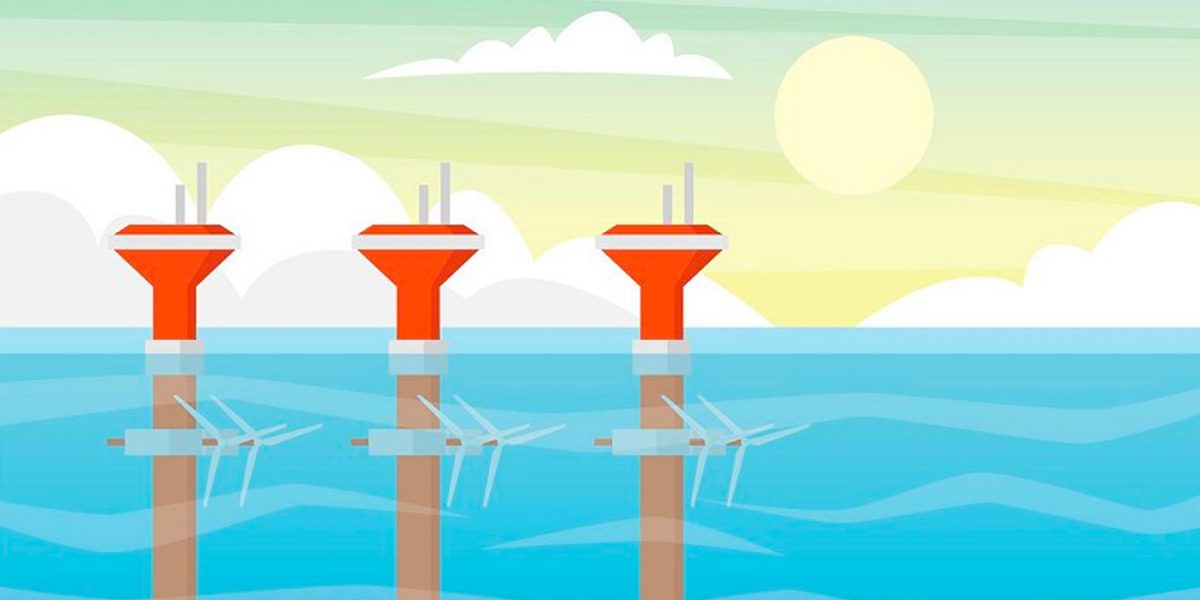Tidal energy is created using the movement of our tides and oceans, where the intensity of the water from the rise and fall of tides is a form of kinetic energy. Tidal power surrounds gravitational hydropower, which uses the movement of water to push a turbine to generate electricity. The turbines are likened to wind turbines, except they are positioned underwater.
The weather in the Scottish Isles allows for the largest production of tidal power in the UK – did you know that the latest figures have shown that Scotland produced enough energy from wind farms in the first half of 2019 to power up to 4.47m homes? Nearly double the amount it has. Across the world, tidal energy is improving, as engineers develop new concepts and technologies to increase energy demand. Here in Northern Ireland, in 2007 at Strangford Lough, the world’s first-ever commercial-scale tidal power station (SeaGen) was developed, consisting of two 600kW turbines.
Tidal can be harnessed in three different ways; tidal streams, barrages, and lagoons. However, as we are still waiting on tidal energy to become more economical, there are a few alternative ways that we can capture tidal energy, highlighted in the video below.
What are the advantages of tidal energy?
- Predictable energy output – tides are predictable and constant, thanks to gravitational forces. Only needing to assess the low or high tide, makes it easier for engineers to design efficient systems.
- As technology advances for tidal, it will get increasingly cheaper and efficient.
- Protects coastal flooding due to the stability of the rock armour under different design conditions. Tidal lagoons can withstand 1 in 500 storm surges and waves a year.
- Equipment and facilities of tidal power can last a lot longer and be more cost-competitive than other renewable technologies. With an asset life of 120 years, developments are made for future increases in sea-level.
What is stopping us from making the most of tidal energy?
- It is currently expensive to construct tidal power plants as they require high capital investments.
- Environmental issues such as habitat change, particularly with tidal barrages.
- Maintaining and repairing equipment can be a challenge.
- Limited energy demand. Powerful tides only happen normally 10 hours out of each day, this means the tidal energy storage capacity must be developed.
- Difficult to provide tidal energy to coastal communities, as the energy produced by the tides is often a long distance from where the electricity will be used inland.
Large-scale tidal power
Currently, the Sihwa Lake project remains the world’s largest tidal power station in operation, located on the west coast of South Korea. The 254 MW Sihwa project, consisting of 10 water turbine generators, has enough power to support the domestic needs of a city with a population of 500,000 people. “The 552.7 GWh of electricity generated from Sihwa tidal power plant is equivalent to 862,000 barrels of oil, or 315,000 tons of CO2 – the amount produced by 100,000 cars annually.” Around 160 million tonnes of water flows in and out of the floodgate and waterwheel, which is responsible for half of the total water quantity in Sihwa Lake. The ongoing circulation of water between the lake and the outer sea during the energy generation process has improved the water quality. With limited energy resources, South Korea is looking to transition to tidal power, to provide an alternative to fossil fuels and develop emission-free clean energy.
What is next for tidal energy?
Tidal energy has the potential to offer all the power we need, eliminating the need for fossil fuels. As stated by Simec Atlantis Energy; “The tide moves a huge amount of water, twice a day. Harnessing it could provide a great deal of energy – around 20% of Britain’s needs”
However, as tidal technology has only been available for a few decades, many challenges remain. British companies and Universities are currently developing a new wave of technology, supported by grants from the £50m Marine Renewables Deployment Fund. Almost 10 years ago, the South West Regional Development Agency installed the Wavehub, the most technologically sophisticated open-access site for testing offshore renewable technologies, 16km off the Cornwall coast. Another company also making a splash in the United Kingdom, is the European Marine Energy Centre (EMEC) in Orkney.
There are definite opportunities associated with tidal and wave stream technologies, which could offer potential solutions in combatting against the world’s climate crisis, whilst achieving the UK’s net-zero target in 2050.
Why not read more about harnessing water to generate energy in our Hydropower blog, or learn about the challenges involved in installing micro-hydropower in water networks in our REDAWN EU project blog.


